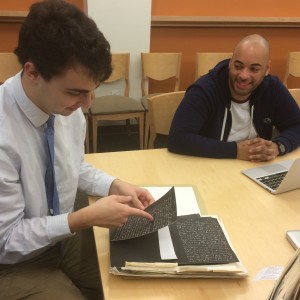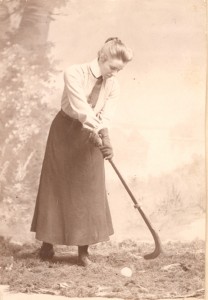This blog post has been written by David Polanco, one of two Temple University students who discovered Bryn Mawr Special Collections last Fall as part of the Greenfield Digital Center’s third year participating in the Cultural Fieldwork Initiative organized by Greenfield Digital Center Advisory Board member and Temple University historian Christine Woyshner. David spent his semester researching the history of women’s sports and women’s colleges — a topic of continuing relevance to both students and the general public.
My field experience at Bryn Mawr College Special Collections was a great one. They manage extensive collections of art, artifacts, rare books, manuscripts, and photographs, and also have a wide-ranging digital archive on the history of women’s education, and resource guides. The Greenfield Digital Center’s online gateway has digital primary resources, instructional activities, and opportunities for teachers and students.
One of the reasons why Bryn Mawr was my top choice [for the Cultural Fieldwork Initiative placement] was because of the chance to learn more about women’s education. Women’s history usually gets lost in the shuffle when teachers teach U.S. History classes. Women are a huge part of the fabric of American history and Bryn Mawr College is a great resource.
Special Collections at Bryn Mawr College offer a plethora of primary sources. This can be useful in the classroom as it contains materials that can be thought provoking for students. What makes Bryn Mawr Special Collections great for teachers, especially Philadelphia students, is connecting content to local history. Teachers and students have the opportunity to find and use the resources they need through Bryn Mawr’s great staff. Most of my time I worked with Monica L. Mercado who is the director. She was a pleasure to work with. Her passion for history is evident from the moment you meet her. The staff also includes assistant director Evan McGonagill and director of Special Collections, Eric Pumroy. There are many friendly faces at the special collections. They were all approachable and very helpful. This is the perfect reason teachers should use this resource.
My focus was women physical education and sports. On my second day there I was welcomed with boxes that contain sources on those subjects. It was awesome. The boxes contained photos, old pamphlets, and letters in abundance. I learned about “The Apple,” Constance Applebee, whom introduced field hockey to the United States. There were old photos of her, and her notes on how to lineup in formation when playing.
[For more on Applebee, read “Constance Applebee and Bryn Mawr,” a digital exhibition, here.]
Performing my field experience at a Special Collections helped me learn how to utilize the resources in my future classroom. First of all, it made think about special collections everywhere. Be it the one at Bryn Mawr, or the Special Collections Research Center at Temple University, these collections are there to be used. Educators should rely on them heavily. For example if I’m teaching a unit on World War I, I can visit Bryn Mawr and ask for resources they have on the topic–or browse a related digital exhibition at the Greenfield Center site. Women were important for both World Wars and Bryn Mawr would have primary sources that I can use in my classroom.
I also learned about digital archives. It doesn’t replace analyzing primary sources by hand and feel, but if I have to bring something up in the classroom, I have a source online to go to. Also if students are taking part in National History Day (NHD), Bryn Mawr is a great place to visit. They also hosts regular local programming that highlights historical and contemporary issues in women’s education. All these resources would help students make an exceptional project for NHD. As a future educator it also gave me first hand experience in incorporating primary sources into lessons.

Temple University students Matt Cahill and David Polanco compare findings in the Special Collections seminar room, November 2014.
I’m excited to have worked in a department that has so many great and interesting resources. On the other hand its sad that it has come to an end. I worked with great people at the archives, which includes the staff, and also another Temple student. We would meet each week and engage on what we doing for our lesson plan. It was a helpful process as they gave constructive criticism, which helped me immensely.
My fieldwork was beneficial to my teaching practice because it opened me up to another world. A world that isn’t all about textbooks, and power points, but instead its one of unlimited promise and excitement. I never knew what I might find in the boxes. When you come across a letter with the date 1896 on it, the feeling you get when you hold such a thing is priceless. This is what teaching history should be. Students should be able to handle and analyze these sources. Its better to touch and feel history compared to always reading about it in an abstract way.
To end my reflection I want to thank the staff at Bryn Mawr. Everyone was always pleasant, and the setting was always enjoyable. I plan to stay in contact with the special collections department because I will use their resources in my future classroom. They have opened my eyes on what archives can do in the classroom. This fact cannot be overlooked. The staff wants teachers and students to use their services. They have resources and materials to help drive conversations in the classroom.
The future Temple students who do their fieldwork at Bryn Mawr are in for a treat. My involvement with the archives is one of best aspects of doing my education at Temple University.

